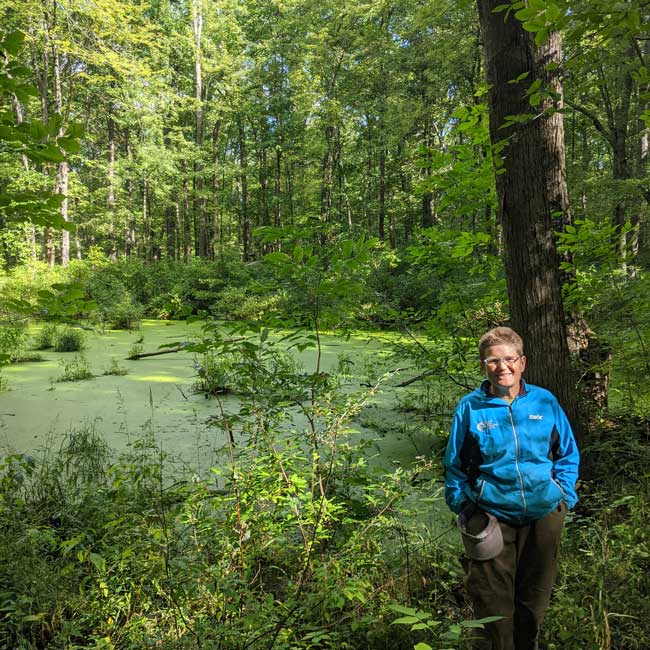What happens on the land affects the Huron River
As Kris Olsson retires from HRWC after 31 years as one of our lead ecologists she leaves behind a legacy of extraordinary leadership, dedication, and passion for the protection of nature. This blog overviews the important HRWC initiatives spearheaded by Kris. It is republished from our Spring 2024 Huron River Report.

I entered the rickety old building at 415 W. Washington with excitement—the internship announcement seemed like a perfect fit for my interests as well as my newly minted degree in Natural Resources (or, “Environmental Education, Advocacy, and Policy”) from the University of Michigan’s School of Natural Resources. I would be helping HRWC staff (there were three of them in 1993) advocate for policies to protect groundwater and educate residents and businesses about how their drinking water comes from groundwater and how they can help protect it.
Three years later, I became a full-fledged staff member, having learned 1) the connection between what happens on the land and what happens to the Huron River, 2) the important role the watershed’s 67 local governments play in land use policies, and 3) the need for environment-minded residents to get involved in those local governments. Over time, I came to realize that the myriad projects I worked on over my 31 years at HRWC have been rooted in those three concepts, with a few addendums (people who know me know I couldn’t limit this to three short statements without caveats and modifications.) I call this the “Unified Theory of Kris at HRWC.”
- We need to protect the forests, wetlands, and other natural areas in the watershed. To do that, we need to figure out what the “right lands” are to protect to make the most impact on the river. We need to encourage local governments, land conservancies, and other organizations to prioritize their limited resources to protect the most valuable remaining natural lands for watershed health.
- For the lands we can’t protect by purchasing preserves or conservation easements, we need local governments to enact policies and ordinances to protect the most important lands from development.
- Finally, we need to recruit people from municipalities across the watershed to become planning commissioners, elected officials, or active allies in watershed protection.
The Natural Areas Assessment Program
The creation of the Natural Areas Assessment and Protection Project in 2000 was the first step towards protecting natural lands across the watershed. Using satellite imagery, we mapped the remaining forests, wetlands and grasslands in the watershed and ran a model that scored each area based on 16 different criteria, such as size, groundwater recharge potential, and vegetation community type. We made the map available to conservation partners, local governments, and sister watershed organizations to guide decision-making towards protecting valuable natural lands in Southeast Michigan.
A few years later came our field assessment program. To gain more insight into the ecological integrity of the remaining natural areas, HRWC recruited and trained volunteers to walk through properties and note the plants, wildlife, and their other ecological characteristics. In the last 15 years, HRWC staff and volunteers have conducted nearly 1000 assessments of forests, wetlands, and grasslands, generating hundreds of ecosystem assessment reports for landowners and partners. The map (Natural Areas of the Huron River Watershed, hrwc.org/maps) and field assessments have provided essential information and data to our many conservancy and local government partners working on land protection.
Green Infrastructure Workshops
In 2013 HRWC launched Green Infrastructure (GI) workshops aimed at building relationships with local governments and supporting their development of policies that promote land protection across the watershed. Through these workshops, policymakers learn about the importance of land conservation for public and environmental health and are encouraged to (among other policies):
- Develop master plans that include maps of their “Green Infrastructure Network” – a product of the GI workshops that includes HRWC’s Natural Areas map, plus connections drawn between natural areas within local communities;
- Enact ordinances that require proposed development projects to avoid wetlands and woodlands and leave habitat-protecting plant buffers along waterways; and
- Enact land protection policies such as conservation millages to fund conservation easements and preserves.
Since the program’s inception, HRWC has led GI workshops in 18 communities. Three communities have enacted local conservation millages. Numerous local governments incorporate green infrastructure planning policies into their master plans and zoning ordinances.
HRWC’s Change Makers Boot Camps
HRWC’s Change Makers Boot Camps and “advanced” trainings recruit residents to be allies—to give public input on land use planning policies and become the next generation of planning commissioners and elected officials. Since 2017, we have held seven Change Makers Boot Camps in seven municipalities. Numerous residents have become strong advocates for land protection in their communities and join their local governments as conservation-minded policymakers.
The rest of the Huron River Report Spring 2024 issue is about the programs I helped create. For me, pretty much my whole time here has been highlighted by the privilege of working with an incredibly competent, clever, kind, and fun-loving staff as well as partners over the years. This was my dream job from the start of my “little” internship at the (now condemned) 415 W. Washington building to our time at the NEW Center right on the river, to our new Huron River Headquarters here at 117 N. First, “with couches and everything!”
Live Long and Prosper, all!
—Kris Olsson
HRWC invites you to consider contributing to the Watershed Resilience Endowment Fund and join Kris’s fight for the protection of our watershed and river forever. Help us honor Kris’s thirty-one-year legacy as she retires from HRWC.



